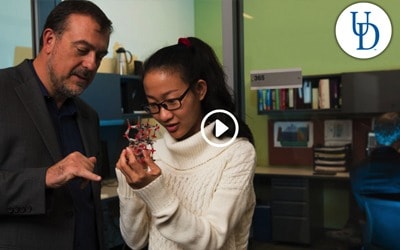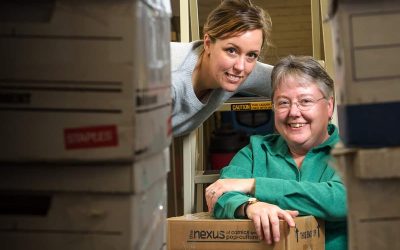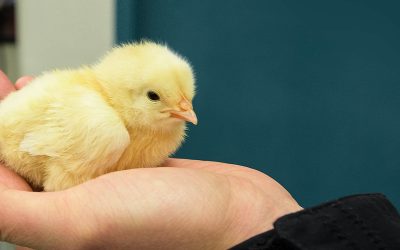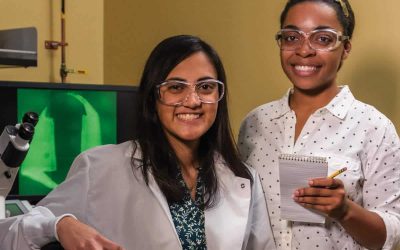
by Beth Miller | August 24, 2016
You can’t put a tree limb or a corncob in your gas tank and expect to get anything but a strange look and a bill from your mechanic.
But that kind of fodder could one day be a fuel source as cheap and common as fossil fuels are now, providing renewable, sustainable raw materials for biorefineries that turn such agricultural waste into fuels, electricity and chemicals.



Catalysis is something like a turbocharger for chemistry, the area where scientists throttle up chemical reactions in order to create new materials more quickly. Each catalyst has its own characteristics—different melting points, boiling points, different responses to other solids or liquids. Scientists look for catalysts with the properties that fit best for the reaction they are pursuing.
CCEI’s mission is to develop a range of new catalysts that will convert inedible biomass—things like wood, switchgrass and other organic waste—into sugars and oils that can then be used in fuels and chemicals. That kind of biomass is much tougher to break down than the soft, squishy corn kernels used to make ethanol, so finding efficient catalysts that don’t do more harm than good would be an important breakthrough.
To speed the research along, the U.S. Department of Energy supplied a catalyst of its own in 2009 when it named CCEI an Energy Frontier Research Center (EFRC) and provided a $17.5 million, five-year grant. DOE renewed its support in 2014, with an additional $12 million grant.
EFRCs are part of DOE’s effort to encourage innovation in the production, use and conservation of energy, and Secretary of Energy Ernest Moniz got a tour of CCEI during his National Lab Day visit to UD in May. Several dozen such centers are scattered around the nation, each working on different projects. CCEI’s focus is catalysis—laying the scientific groundwork for the best ways to refine this rugged type of biomass.
“The impact it can have on the education of students, on the economy and on emissions can be tremendous.”
—Dion Vlachos

“This is a huge opportunity to solve these problems,” said Dion Vlachos, founder and director of CCEI and Elisabeth Inez Kelley Professor of Chemical Engineering at UD. “It’s a grand challenge. And an individual investigator cannot solve all these problems. You need 20 to 30 investigators—a large group. The impact it can have on the education of students, on the economy and on emissions can be tremendous.”
Biofuels are no silver bullet for the problems of climate change, said Mark Barteau, director of the University of Michigan Energy Institute, DTE professor of advanced energy research, and professor of chemical engineering. But CCEI’s research and approach to this challenge will be valuable as manufacturers look for better ways to make a range of products that now rely on oil and hydrocarbons, he said.
 Barteau knows CCEI and the challenges of catalysis well. He was on UD’s faculty for 30 years, is the Robert L. Pigford Chair Emeritus of Chemical and Biomolecular Engineering, founder of the University’s Energy Institute and served as director of its Center for Catalytic Science and Technology. By the time CCEI was formed in 2009, Barteau was UD’s senior vice provost for research and strategic initiatives. He joined the Michigan faculty in 2012, but still serves on CCEI’s advisory board.
Barteau knows CCEI and the challenges of catalysis well. He was on UD’s faculty for 30 years, is the Robert L. Pigford Chair Emeritus of Chemical and Biomolecular Engineering, founder of the University’s Energy Institute and served as director of its Center for Catalytic Science and Technology. By the time CCEI was formed in 2009, Barteau was UD’s senior vice provost for research and strategic initiatives. He joined the Michigan faculty in 2012, but still serves on CCEI’s advisory board.
He remains impressed by Vlachos’ ability to pull multiple institutions together for this work. CCEI’s research partners include Brookhaven National Laboratory, California Institute of Technology, Columbia University, Georgia Institute of Technology, Lehigh University, Rutgers University, the University of Massachusetts Amherst, the University of Minnesota and the University of Pennsylvania.
“People collaborate, yes, but oftentimes in things like this, they like to take their money, go to their corner and do their thing,” he said. “Dion Vlachos is very effective in getting everybody marching in the same direction. To make that team function as if it was all in the same place is not an easy thing to do.”
CCEI’s industry partnerships also are important avenues for putting research-based technology to use, Barteau said.
“The strategy of making things for which there is a well-established market—but making them from bio-based resources via catalysis—is one of the distinguishing characteristics of the center and one of its most important contributions,” he said. “It is one of the most productive and highest-impact EFRCs that DOE has funded.”

Momentum building for renewables
While the potential benefits of renewable energy—wind, solar, biofuels—are significant for the economy and the environment, the adjustment costs and other challenges remain too great to dethrone fossil fuels anytime soon. And with gas prices not far from $2 a gallon and a glut of oil that has some producers wondering where to put it all, it’s harder to make the case that finding alternative energy is a pressing need.
The bottom line must be addressed, Vlachos said, and that is part of this grand challenge, too.
“You have to be economically competitive and environmentally benign. If you have to pay a dollar extra for a gallon of [biomass] gas—you are not willing to do that.”
The market for fossil fuels is fickle, volatile and affected by dynamics far beyond the industry’s control, though.
It was just three or four years ago that gas reached $4 a gallon and prime-time newscasts were filled with images of crude oil gushing into the Gulf of Mexico’s ecosystem after BP’s deadly offshore incident.
As oil prices have plummeted more recently, some parts of the industry have contracted with layoffs, bankruptcies and closures.
Beyond the shores of the United States, the vulnerabilities of the supply chain came into sharp focus in 1973, when the Organization of Petroleum Exporting Countries (OPEC) turned its “To America” valves toward the “off” position, creating long lines at gas stations and increased concern about the nation’s dependence on foreign oil.
Changing the realities of supply, demand and geopolitics requires good science and research that sometimes seems maddeningly slow.
But CCEI is building momentum.
“We have some new chemistries and provisional patents—very, very exciting work,” Vlachos said. “We have a lot of potential to touch everyday life.”



Conquering the chemistry of new catalysts
Everyday life at CCEI headquarters in UD’s Harker Interdisciplinary Science and Engineering Laboratory requires a good bit of hustle.
Dozens of students and postdoctoral researchers are working with principal investigators around the nation to test new catalytic reactions in the lab, explore promising options with computer models and study the effects in exhaustive detail, using reactors, analytics, X-ray spectros- copy and high-powered microscopes.
Regular discussions with industry partners help to move ideas from the drawing board and the proving ground into the workflow and scale of a biorefinery. A new catalytic process may eliminate the need for material “X” or step “Y,” reducing costs and improving efficiency for producers and offering effective new substitutes for rare or environmentally toxic substances that may be in the mix of some products now.
Success could be green, indeed—and not just for the environment. The market for biomass-based products already is in the billions of dollars, with analysts seeing increased potential for new applications in packaging, detergents, coatings, plastics and clothing, among others.
But there is complicated chemistry to conquer first, said Associate Director of Research Basu Saha, who did similar research with Dow Chemical before joining CCEI last year. Trees and other woody substances don’t give up their stores of energy easily.
Sunitha Sadula, a postdoctoral researcher, has been working on that problem for five years.
She studies how various catalysts affect the polymers found in plant cell materials known as cellulose, hemicellulose and lignin. Each polymer has different characteristics that must be considered during the effort to extract the sugary energy embedded within.
Recently, for example, she has been working with molten salt hydrate, a catalyst that has advantages for the hydrolysis reaction needed to break down cellulose. The hydrate reduces the acid content needed in the solution, and using less acid is a good thing for protecting reactors and their mechanical parts.
Sadula also works to reuse materials—an effort to increase efficiency. If she can separate extracted sugars from molten salt hydrate, for example, she can reuse that hydrate, a very stable mixture with a high boiling point, for other reactions.
The challenges increase when she moves from examining one compound, as she has in her research so far, to studying the effects of different catalysts on the full biomass substance, which she is excited to begin.
“Biomass is a very complicated system,” she said. “I don’t know how many compounds I am going to see. Our study has been on individual compounds.”
Graduate student Hannah Nguyen has been working with furans, extracted from the sugars in biomass, to create larger compounds suitable for use in diesel and other fuels.
She has worked with different solutions—water, toluene, alcohol, for example—and a variety of solids. She studies not only the activity of the catalysts but also the mechanism in play.
“I’m working not only to find the best catalyst, but also to know if something does not work—why does it not work?” she said.
Near the experimental lab, other scientists are developing computer models of chemical reactions in an effort to predict not only what might work well, or not, but also to see what happens in the processes involved, from changes at the nanoscale to changes throughout an entire industrial system.

“The real world is extremely complex,” said Tyler Josephson, a doctoral candidate in chemical and biomolecular engineering who works on CCEI’s computer modeling team. “It’s often very difficult to understand exactly what’s going on between the atoms as they move around and make new bonds and break other bonds. But in the computer, you can define things very specifically. You can carefully control all the different effects.”
If the goal is to turn one kind of sugar into another—going from glucose to fructose or mannose, for example—the chemical process may require a dozen different steps. With computer simulation, Josephson can see those steps in detailed sequence and determine where things might get bogged down, where a catalyst might be most beneficial.
His current project involves that kind of analysis on a new catalyst developed and now in testing in Mark Davis’ lab at the California Institute of Technology.
“If you’re working on an assembly line and one guy is slower than everybody else, you can only go as fast as he can,” Josephson said. “So if we find the slowest step, when we’re engineering a catalyst we want to target that one.”
He can also predict how materials will interact downstream and see where other adjustments may be needed to prevent degradation or account for changes in the materials.
No such predictive tool existed until recently, Vlachos said. With that capacity, CCEI can screen the periodic table and determine which elements will probably be best suited in given situations.
In addition to building the science of heterogeneous catalysis, that is, the use of liquid and solid catalysts together, CCEI also has developed new materials that allow precise control over the reactions. One example is its ability to adjust pore sizes in a zeolite, for example, to allow liquids to move more easily to targeted areas, making reactions faster, more stable and easier to tailor at no additional cost.
CCEI’s large cadre of collaborators—chemists, chemical engineers, physicists and others—bring invaluable strengths, looking at different angles of the same challenges, pointing out obstacles, suggesting solutions and preventing unnecessary complications.
“Collaboration is extremely important, and it is becoming more and more important as research progresses,” Josephson said. “The problems that one area of study can solve all by itself are disappearing. New problems require contributions from many fields.”
Biofuels and the environment
The quest for alternatives to fossil fuels has produced its share of unintended consequences.
The emergence of corn ethanol as a renewable fuel additive raised difficult questions, for example. As an additive to gasoline, representing about 10 percent of most gallons now sold in the U.S., ethanol relieves some demand for that fossil fuel.
But as corn’s potential role in renewable energy was touted, its price points rose. Land and other resources previously devoted to food production were shifted to growing corn for ethanol production. As the implications for humans became clear—food was becoming much more expensive—corn ethanol’s early appeal was tamped down.
CCEI’s work addresses that complication with its focus on inedible biomass—waste products that would otherwise be discarded or tilled into the land. Such materials can be harvested on land that would not support food production and can also be derived from regular crops after the foodstuff is harvested.
Still, land management is a continuing challenge. Concerns have been raised about how repurposing large tracts of land would affect biodiversity and deforestation and whether production of biofuels will reduce harmful carbon emissions in significant ways or just shift the environmental burdens from one area to another. The potential of biomass as an environmental upgrade from fossil fuels is tempered by its need for land and water resources, the use of pesticides and the use of petroleum products to distribute the harvested materials.
Biofuels may not be the solution to all of the problems fossil fuels present, but they don’t have to replace all fossil fuels to play a valuable role in reducing carbon emissions. And as the chemistry and technology advance, other gains are possible, with the National Academy of Sciences projecting a 40 percent drop in operating costs for biochemicals by 2035.
Fueling an energy-hungry world
Developing the chemistry required to convert inedible biomass from a hopeful possibility to a significant, market-friendly source of renewable, sustainable, environmentally benign energy is a tall order indeed.
The woody stuff used in CCEI’s research—known as lignocellulosic biomass—is tougher to refine than corn or sugarcane because of the cellular structure inherent in things like stalks and branches. The qualities that make them strong enough to support crops and withstand the elements also make them tougher to break down into the sugars needed to produce fuel and other chemicals. The right mix of catalysts is important to do that job.
“We need to deconstruct three components and this is a challenge,” Saha said.
Left to the great compost heap of prehistoric Planet Earth, those branches and stalks and other organic material would decompose and join the massive hydrocarbon cemeteries from which fossil fuels such as crude oil, natural gas or coal are now drilled or extracted.
But that isn’t fast fuel. It takes millions of years, paleontologists say, and the world’s high demand for fossil fuels is drawing down the planet’s limited reserves at rates much faster than they are replaced.
That’s why the shift to greater reliance on biomass-based fuels and chemicals has captured the imagination of many scientists and students who hope their work will make a lasting and helpful difference in this energy-hungry world.
“No one group can do this,” Josephson said. “No one person can do it. But having a common vision creates a powerful, effective and highly productive research organization.”
“The real world is extremely complex.”
—Tyler Josephson
MORE STORIES
Energy IQ
Put your Energy IQ to the test, and let’s see if you are an energy guru or a fossil fool.
Catalysis Center for Energy Innovation
Cool video highlights CCEI’s mission of turning cornstalks and wood chips into fuels, electricity and chemicals.
Scanlon papers now part of disaster resource collection
T. Joseph Scanlon, a respected journalism professor in Canada, had a long-time relationship with the University of Delaware’s Disaster Research Center, which is now the repository of his over 70,000-piece collection.
Honors
The UD community celebrates its first Gates Cambridge Scholar, two new fellows in the National Academy of Inventors, and the first woman to receive the Soil Science Society of America’s Kirkham Soil Physics Award.
News briefs
A humanoid robot joins the pediatric rehab team, a new UD study suggests online shopping may not be as “green” as we thought, a professor aims to improve student experiences in global health, and summer research all-stars take the field.
Keeping a killer flu in check
Who do you call when bird flu comes knocking? UD’s Avian Biosciences Center is working to contain the threat of bird flu—locally and globally.
Research Magazine Survey
We value your opinion. To show you how much, we will award a $100 Barnes & Noble gift card to three people who complete our survey. To be entered in this random drawing, please complete the survey by Nov. 1, 2016.
UD Authors
In her award-winning book, historian Christine Heyrman explores how the first U.S. missionaries in the Middle East influenced a nation’s attitudes toward Islam.
What science writing can teach us
Journalist, author and UD’s Distinguished Writer in Residence Mark Bowden shares lessons he learned as a science writer and recent samples of his students’ work.
New Train Station Project on Track for STAR Campus
An upgraded transportation hub in Newark will bring new riders and serve as an anchor for UD’s 272-acre Science, Technology and Advanced Research (STAR) Campus.
A trusted partner when the world turns upside down
Decisions made in times of disaster can be the difference between life and death, restoration and ruin. UD’s Disaster Research Center offers field-tested methods to strengthen recovery efforts.
Ch-Ch-Ch-Changes…
With significant change all around us, Delaware’s leaders—including the University of Delaware—are working to turn adversity into new opportunity.














